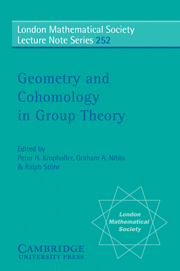Book contents
- Frontmatter
- Contents
- Preface
- List of Participants
- On the Cohomology of SL2(ℤ[1/p])
- Cohomology of Sporadic Groups, Finite Loop Spaces, and the Dickson Invariants
- Kernels of Actions on Non-positively Curved Spaces
- Cyclic Groups Acting on Free Lie Algebras
- Cohomology, Representations and Quotient Categories of Modules
- Protrees and Λ-trees
- Homological Techniques for Strongly Graded Rings: A Survey
- Buildings are CAT(0)
- On Subgroups of Coxeter Groups
- The p-primary Farrell Cohomology of Out(Fp–1)
- On Tychonoff Groups
- Word Growth of Coxeter Groups
- Poly-surface Groups
- Analytic Versions of the Zero Divisor Conjecture
- On the Geometric Invariants of Soluble Groups of Finite Prüfer Rank
- Some Constructions Relating to Hyperbolic Groups
- Free Actions of Abelian Groups on Groups
- Finitely Presented Soluble Groups
On Tychonoff Groups
Published online by Cambridge University Press: 01 April 2010
- Frontmatter
- Contents
- Preface
- List of Participants
- On the Cohomology of SL2(ℤ[1/p])
- Cohomology of Sporadic Groups, Finite Loop Spaces, and the Dickson Invariants
- Kernels of Actions on Non-positively Curved Spaces
- Cyclic Groups Acting on Free Lie Algebras
- Cohomology, Representations and Quotient Categories of Modules
- Protrees and Λ-trees
- Homological Techniques for Strongly Graded Rings: A Survey
- Buildings are CAT(0)
- On Subgroups of Coxeter Groups
- The p-primary Farrell Cohomology of Out(Fp–1)
- On Tychonoff Groups
- Word Growth of Coxeter Groups
- Poly-surface Groups
- Analytic Versions of the Zero Divisor Conjecture
- On the Geometric Invariants of Soluble Groups of Finite Prüfer Rank
- Some Constructions Relating to Hyperbolic Groups
- Free Actions of Abelian Groups on Groups
- Finitely Presented Soluble Groups
Summary
Introduction
The class AG of amenable groups can be characterized by the property that the group has a fixed point for any action by affine transformations on a convex compact subset of a locally convex topological vector space.
Now let us suppose that instead of a compact set we have a nonzero cone. What kind of fixed-point theorems may hold in this situation? There is a number of conditions under which a selftransformation of a cone has a nonzero fixed point. We will consider the situation when a group acts by affine transformations on a convex cone with compact base. The groups for which any such action has an invariant ray are called Tychonoff groups and were defined by H. Furstenberg [5].
The Tychonoff property was also considered in [3,6] in the greater generality of locally compact groups and used for the description of positive harmonic functions on groups which contain closed nilpotent subgroups with compact quotient.
In this paper we try to attract the attention of the reader to Tychonoff groups again, and begin the systematic investigation of abstract Tychonoff groups (with the discrete topology).
Among other observations we show that the class of Tychonoff groups is closed under the operations of taking factor groups and direct limits, but it is not closed under taking subgroups. It is also not closed with respect to extensions but some sufficient conditions for a semidirect product of Tychonoff groups to be Tychonoff are given.
- Type
- Chapter
- Information
- Geometry and Cohomology in Group Theory , pp. 170 - 187Publisher: Cambridge University PressPrint publication year: 1998
- 2
- Cited by

